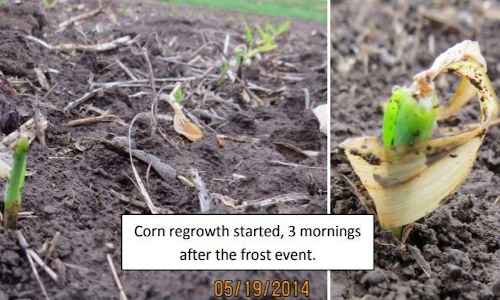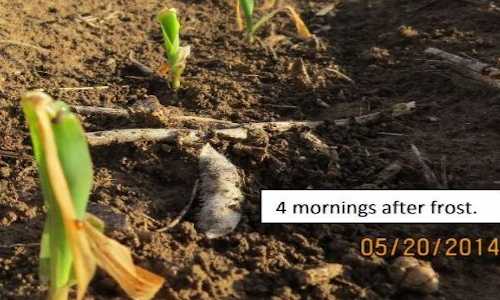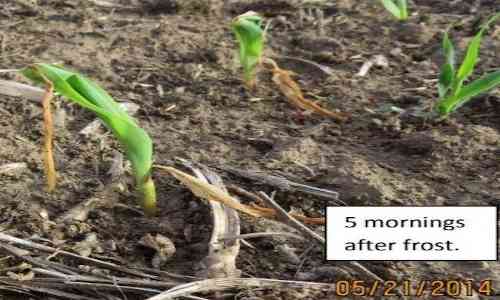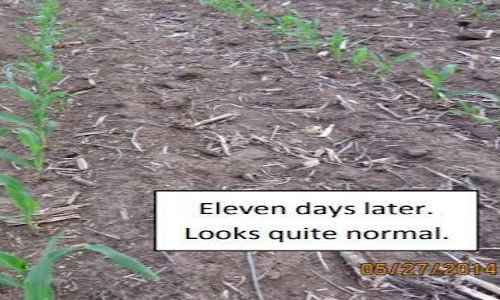By Joel DeJong
Years like this, when corn-planting progress is ahead of normal and we get really optimistic about it, frost raises its ugly head. In the NW corner of Iowa, about a third of the years will include a frost in May. About ten percent of the time it is after May 10. Watching the recovery of emerged corn plants is not a new phenomenon, but it still looks ugly. What should you do when this happens? Wait a few days, eliminate emotion, and evaluate regrowth. Sometimes looking at what has happened in the past gives us insight into what might happen now.
April and early May of 2014 offered some great opportunities to get the crop planted here in NW Iowa. Early May weather was quite warm – it reached 91 degrees in Le Mars on May 7, so lots of corn had emerged. Of course, it cooled down. From the 14th to the 17th overnight lows were right around 32 degrees in town – with reports significantly lower from local crop producers. The coldest night was the 16th, measuring 26 degrees. Many calls were received about the “dead” corn. Wait a few days for recovery, and then make a decision was the offered advice. The recovery days after that averaged about 58 degrees and then warmed some more a week later. That seems similar to this year, except we maybe have been a little cooler the last few days since the frost. What did corn plants do? I followed a few plants I had flagged the morning after the coldest night to see what happened. Here are the pictures.





It does take a little time for recovery. Frosted plants I observed this morning, Wednesday (May 13, 2020), were showing about a ¼” of new growth, so it appears that the process will be a little slower this year. Our cold morning was Saturday – about four days ago. However, the average temperature since then has only been 46 degrees.
If, in a couple of days, some are recovering and some are not, then split a few stems and evaluate the color of the growing point to see if it is still a creamy white, or starting to brown. When you can differentiate the living plants versus those that are not recovering, do stand counts, evaluate gaps and then make a decision. The recovering plants might "buggy whip" until that old tissue falls off, but it is tender tissue, and it will. Again, take out the emotion.
Did we stress those plants, even the ones that recovered? Yes, but young seedlings bounce back pretty well. Can diseases enter that wound area and cause additional damage? Yes, that is why we really need to look closely after a few days to insure it is recovering as we expect. In addition, delay adding other stresses until we show good recovery. For example, I encourage at least one new, healthy leaf before herbicide applications to reduce that stress.
I do not have soybean pictures, but the advice remains the same. Wait a few days to evaluate how many plants are actively growing. If we killed the unifoliates that were open, are we getting growth from alternate buds? Is the growth continuing normally? Then evaluate the existing stand and gaps compared to the cost and benefits of replanting. Take out the emotion and make a true business decision.
Source : iastate.edu